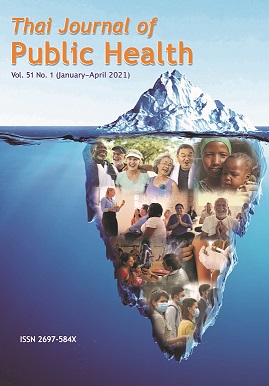Evaluation of physicochemical, sensory, antioxidant and nutritional properties of latte drinks from Chaya (Cnidoscolus aconitifolius) leaves
Keywords:
Latte drink, Cnidoscolus aconitifolius, Physicochemical properties, Antioxidant properties, Sensory properties, Nutritional propertiesAbstract
This study aimed to develop a latte drink from Chaya (Cnidoscolus aconitifolius) leaves and evaluate its physicochemical, antioxidant, nutritional and sensory properties. The cyanide content and physicochemical properties of dried leaf powder were determined. The results showed that the cyanide level of Chaya leaf powder was less than 0.20 mg/L. The color of dried leaf powder had a brightness (L*) of 49.04 ± 0.45 with green (-5.93±0.09) and yellow (24.50±0.29). The water activity and percent moisture of the powder were 0.26±0.00 and 5.51±0.21, respectively. A suite of latte drinks using different amounts of powder ranging from 0.50-3.00 g of Chaya powder were developed. Adding 0.50-1.00 g of Chaya powder to the latte drink did not significantly affect the color value. The viscosity of latte drinks ranged from 16.48 to 32.80 cp. Moreover, the phenolic and flavonoid contents, as well as the antioxidant activity of the latte drinks were quantified. The Chaya latte drinks contained phenolics and flavonoids in the range of 146.71 to 280.39 mgGAE/100 mL and 26.04 to 53.39 mgQE/100 mL, respectively. The antioxidant activity based on percent inhibition of latte drinks ranged from 30.81 to 53.48. A sensory test conducted using 50 participants showed that the formula with 0.50 g of powder had the highest overall acceptance score (7.04±1.47), but this score did not significantly differ from the formula with 1.00 g of powder (6.34±1.38). Based on the results, 1.00 g of powder (37.2 kcal) was a suitable amount of Chaya powder for a latte drink product.
References
Vukasovic T. Consumers’ perceptions and behaviors regarding organic fruits and vegetables: marketing trends for organic food in the twenty-first century. Journal of International Food & Agribusiness Marketing 2016; 28(1): 59-73.
Appleton KM, Hemingway A, Saulais L, Dinnella C, Monteleone E, Depezay L, et al. Increasing vegetable intakes: Rationale and systematic review of published interventions. European Journal of Nutrition 2016; 55(1): 869–96.
Moura LFWG, Neto JXS, Lopes TDP, Benjamin SR, Brito FCR, Magalhaes FEA, et al. Ethnobotanic, phytochemical uses and ethnopharmacological profile of genus Cnidoscolus spp. (Euphorbiaceae): A comprehensive overview. Biomedicine & Pharmacotherapy 2019; 109(1): 1670-9.
Oyagbemi AA, Odetola AA. Hepatoprotective and nephroprotective effects of Cnidoscolus aconitifolius in protein energy malnutrition induced liver and kidney damage. Pharmacognosy Research 2013; 5(4): 260-4.
Iwuji SC, Egenonu CA, Ndubuka GIN, Azeez TO, Ekezie J, Dozie INS, et al. Phytochemical constituents and antibacterial activities of aqueous and hydromethanolic leaf extracts of chaya (cnidoscolus aconitifolius). Futo Journal Series 2016; 2(1): 195-204.
Adaramoye OA, Aluko A, Oyagbemi AA. Cnidoscolus aconitifolius leaf extract protects against hepatic damage induced by chronic ethanol administration in Wistar rats. Alcohol and Alcoholism 2011: 1-8.
Fagbohun ED, Egbebi AO, Lawal OU. Phytochemical screening, proximate analysis and in-vitro antimicrobial activities of methanolic extract of Cnidoscolus aconitifolius leaves. International Journal of Pharmaceutical Sciences Review and Research 2011; 13(1): 28-33.
Obichi EA, Monago CC, Belonwu DC. Effect of cnidoscolus aconitifolius (family euphorbiaceae) aqueous leaf extract on some antioxidant enzymes and haematological parameters of high fat diet and streptozotocin induced diabetic Wistar albino rats. Journal of Applied Sciences and Environmental Management 2015; 19(1): 201-9.
Akachukwu D, Okafor PN, Ibegbulem CO. Phytochemical content of Cnidoscolus aconitifolius and toxicological effect of its aqueous leaf extract in Wistar rats. Journal of Investigational Biochemistry 2014; 1(1): 26-31.
Otitolaiye CA, Asokan C. GC-MS analysis of Cnidoscolus aconitifolius leaf aqueous extracts. International Journal of Science and Research 2016; 5(8): 471-5.
Kuri-Garcia A, Chavez-Servin JL, Guzman-Maldonado SH. Phenolic profile and antioxidant capacity of Cnidoscolus chayamansa and Cnidoscolus aconitifolius: A review. Journal of Medicinal Plants Research 2017; 11(45): 713-27.
Ilao SMM, Panabang MB, Depositario DPT, Baticados GN. Product attribute analysis for latte drinks: Implications for a coffee-flavored carabao milk-based drink. International Food Research Journal 2017; 24(1): 142-7.
Shahidi f, Ambigaipalan P. Phenolics and polyphenolics in foods, beverages and spices: Antioxidant activity and health effects – A review. Journal of Functional Foods 2015; 8(1): 820–97.
Sanchez-Rangel JC, Benavides J, Heredia JB, Cisneros-Zevallosc L, Jacobo-Velazquez DA. The Folin–Ciocalteu assay revisited: Improvement of its specificity for total phenolic content determination. Analytical Methods 2013; 5: 5990–9.
Herald TJ, Gadgil P, Tilley M. High-throughput microplate assays for screening flavonoid content and DPPH-scavenging activity in sorghum bran and flour. Journal of the Science of Food and Agriculture 2012; 96: 2326-31.
Pal TK, Kalita P, Barman TK, Chatterjee TK, Maity S. Quantification of total flavonoid content and antioxidant activity in comparison to a reference flavonoid as in vitro quality evaluation parameter for assessing bioactivity of biomarkers in herbal extracts or formulations. JPR:BioMedRx: An International Journal 2013; 1(8): 757-66.
Khettaf A, Belloula N, Dridi S. Antioxidant activity, phenolic and flavonoid contents of some wild medicinal plants in southeastern Algeria. African Journal of Biotechnology 2016; 15(12): 524-30.
Upadhyay RK. Plant pigments as dietary anticancer agents. International Journal of Green Pharmacy 2018; 12(1): 93-107.
Khachatourians GG, Arora DK. Applied mycology and biotechnology. Amsterdam, The Netherlands: Elsevier Science; 2002.
Godinez-Santillan RI, Chavez-Servin JL, Garcia-Gasca T, Guzman-Maldonado H. Phenolic characterization and antioxidant capacity of alcoholic extracts from raw and boiled leaves of Cnidoscolus aconitifolius (Euphorbiaceae). Acta Botanica Mexicana 2019; 126: 1-15.
Ajiboye BO, Ojo OA, Okesola MA, Oyinloye BE, Kappo AP. Ethyl acetate leaf fraction of Cnidoscolus aconitifolius (Mill.) I. M. Johnst: antioxidant potential, inhibitory activities of key enzymes on carbohydrate metabolism, cholinergic, monoaminergic, purinergic, and chemical fingerprinting. International Journal of Food Properties 2018; 21(1): 1697-715.
World Health Organization. Hydrogen cyanide and cyanides: Human health aspects. Concise International Chemical Assessment Document 2004; 61: 5.
Dikeman CL, Fahey GC. Viscosity as related to dietary fiber: A review. Critical Reviews in Food Science and Nutrition 2006; 46(8): 649-63.
Roland WSU, Vincken J, Gouka RJ, Buren LV, Gruppen H, Smit G. Soy isoflavones and other isoflavonoids activate the human bitter taste receptors hTAS2R14 and hTAS2R39. Journal of Agricultural and Food Chemistry 2011; 59: 11764–71.
Downloads
Published
Issue
Section
License
Creative Commons License CC-BY-ND


